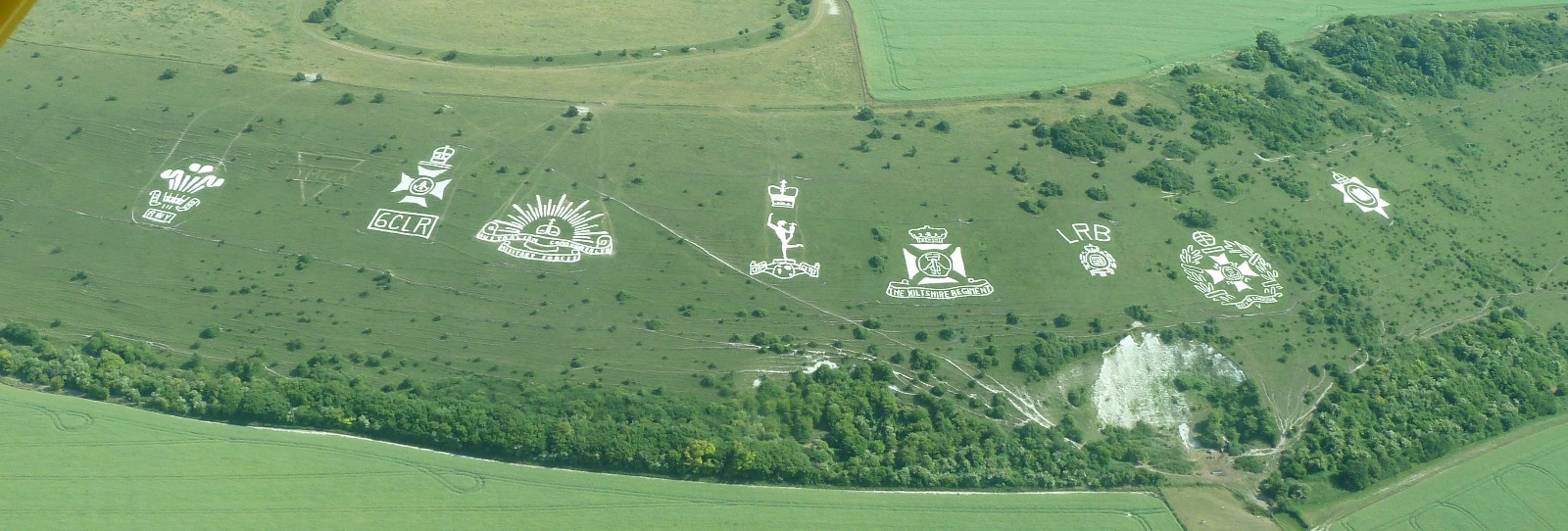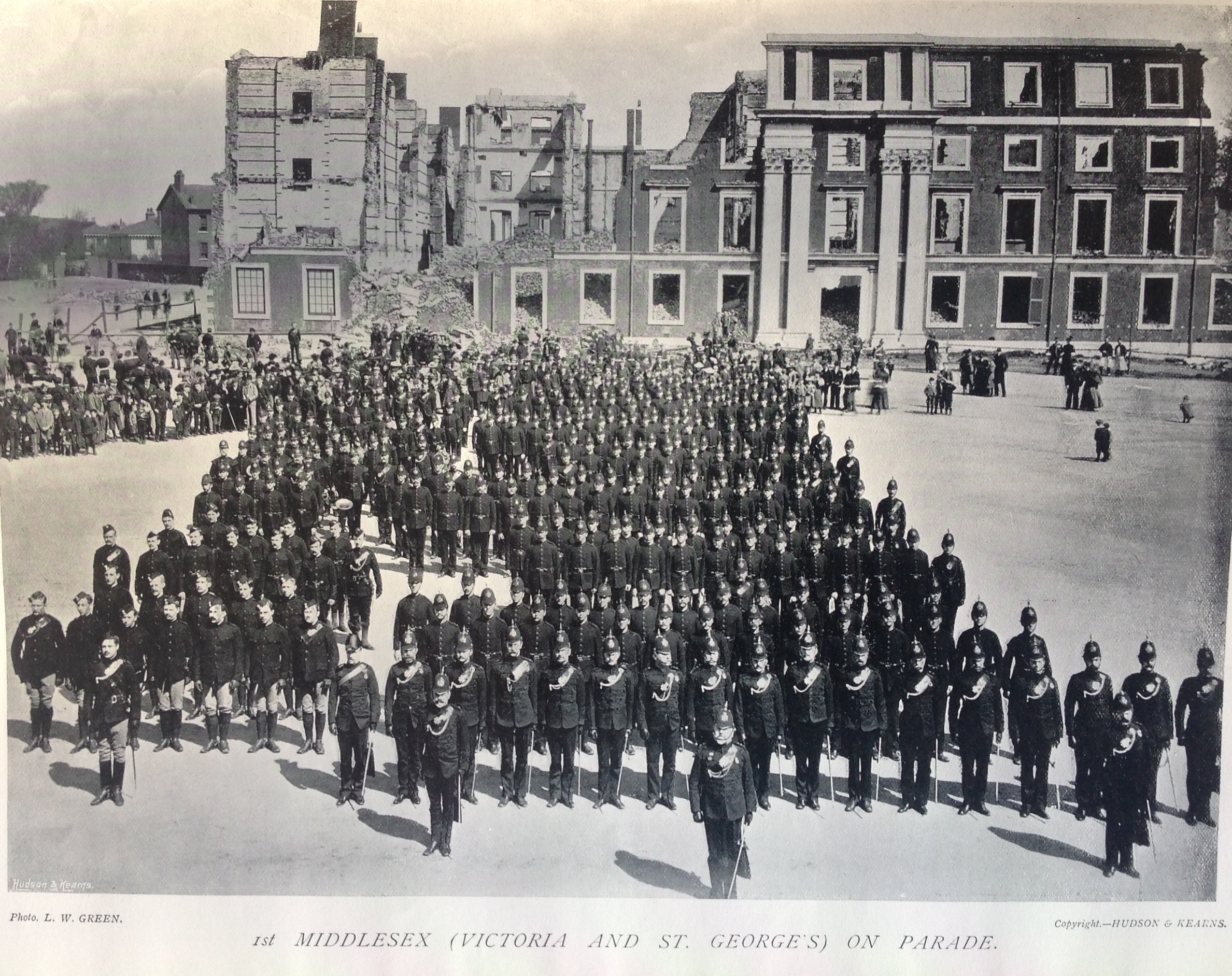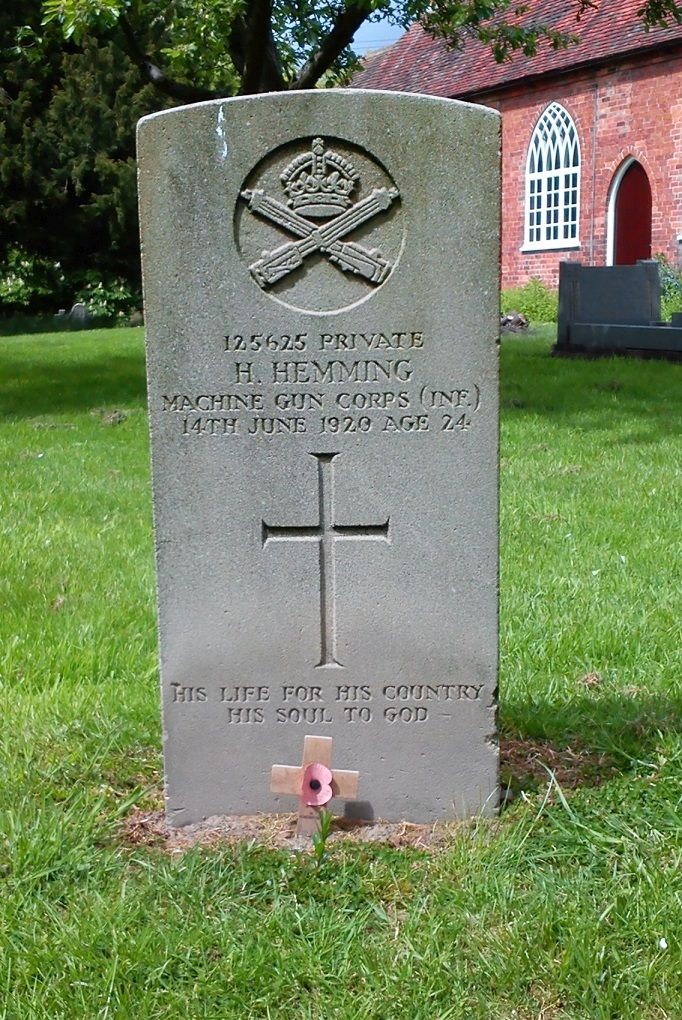|
Fovant Badges
The Fovant Badges are a set of regimental badges cut into a chalk hill, Fovant Down, near Fovant, in southwest Wiltshire, England. They are located between Salisbury and Shaftesbury on the A30 road in the Nadder valley; or approximately southeast of Fovant. They were created by soldiers garrisoned nearby, and waiting to go to France, during the First World War; the first in 1916. They are clearly visible from the A30 road which runs through the village. Nine of the original twenty remain, and are scheduled ancient monuments and recognised by the Imperial War Museum as war memorials. Further badges have been added more recently. The Fovant Badge Society holds an annual Drumhead Service which is attended by the Australian High Commissioner, local mayors and members of parliament. These services fund the upkeep of the badges. Construction After the outlines were cut into the grass-covered hillsides, they were refilled with chalk brought from a nearby slope, up to 50 tons pe ... [...More Info...] [...Related Items...] OR: [Wikipedia] [Google] [Baidu] |
Fovant Badges
The Fovant Badges are a set of regimental badges cut into a chalk hill, Fovant Down, near Fovant, in southwest Wiltshire, England. They are located between Salisbury and Shaftesbury on the A30 road in the Nadder valley; or approximately southeast of Fovant. They were created by soldiers garrisoned nearby, and waiting to go to France, during the First World War; the first in 1916. They are clearly visible from the A30 road which runs through the village. Nine of the original twenty remain, and are scheduled ancient monuments and recognised by the Imperial War Museum as war memorials. Further badges have been added more recently. The Fovant Badge Society holds an annual Drumhead Service which is attended by the Australian High Commissioner, local mayors and members of parliament. These services fund the upkeep of the badges. Construction After the outlines were cut into the grass-covered hillsides, they were refilled with chalk brought from a nearby slope, up to 50 tons pe ... [...More Info...] [...Related Items...] OR: [Wikipedia] [Google] [Baidu] |
City Of London Rifles
A city is a human settlement of notable size.Goodall, B. (1987) ''The Penguin Dictionary of Human Geography''. London: Penguin.Kuper, A. and Kuper, J., eds (1996) ''The Social Science Encyclopedia''. 2nd edition. London: Routledge. It can be defined as a permanent and densely settled place with administratively defined boundaries whose members work primarily on non-agricultural tasks. Cities generally have extensive systems for housing, transportation, sanitation, utilities, land use, production of goods, and communication. Their density facilitates interaction between people, government organisations and businesses, sometimes benefiting different parties in the process, such as improving efficiency of goods and service distribution. Historically, city-dwellers have been a small proportion of humanity overall, but following two centuries of unprecedented and rapid urbanization, more than half of the world population now lives in cities, which has had profound consequences for g ... [...More Info...] [...Related Items...] OR: [Wikipedia] [Google] [Baidu] |
City Of London Regiment
The Royal Fusiliers (City of London Regiment) was a line infantry regiment of the British Army in continuous existence for 283 years. It was known as the 7th Regiment of Foot until the Childers Reforms of 1881. The regiment served in many wars and conflicts throughout its long existence, including the Second Boer War, the First World War and the Second World War. In 1968, the regiment was amalgamated with the other regiments of the Fusilier Brigade – the Royal Northumberland Fusiliers, the Royal Warwickshire Fusiliers and the Lancashire Fusiliers – to form a new large regiment, the Royal Regiment of Fusiliers. The Royal Fusiliers War Memorial, a monument dedicated to the almost 22,000 Royal Fusiliers who died during the First World War, stands on Holborn in the City of London. History Formation It was formed as a fusilier regiment in 1685 by George Legge, 1st Baron Dartmouth, from two companies of the Tower of London guard, and was originally called the Ordnance Regiment ... [...More Info...] [...Related Items...] OR: [Wikipedia] [Google] [Baidu] |
Queen Victoria's Rifles
The 9th (County of London) Battalion, London Regiment (Queen Victoria's Rifles) was a Territorial Army infantry Infantry is a military specialization which engages in ground combat on foot. Infantry generally consists of light infantry, mountain infantry, motorized infantry & mechanized infantry, airborne infantry, air assault infantry, and marine i ... battalion of the British Army. The London Regiment (1908–1938), London Regiment was formed in 1908 in order to regiment the various Volunteer Force (Great Britain), Volunteer Force battalions in the newly formed County of London, and the Queen Victoria's Rifles were one of twenty six units brought together in this way. History Early history The Queen Victoria’s Rifles could trace their origins back to the old volunteer regiments of the Napoleonic Wars when the Duke of Cumberland's Sharpshooters were formed as a Corps of Riflemen on 5 September 1803. The regiment was raised as the 1st (Victoria Rifle Club) Middlese ... [...More Info...] [...Related Items...] OR: [Wikipedia] [Google] [Baidu] |
Machine Gun Corps
The Machine Gun Corps (MGC) was a corps of the British Army, formed in October 1915 in response to the need for more effective use of machine guns on the Western Front in the First World War. The Heavy Branch of the MGC was the first to use tanks in combat and was subsequently turned into the Tank Corps, later called the Royal Tank Regiment. The MGC remained in existence after the war until it was disbanded in 1922. Formation At the outbreak of the First World War in August 1914, the tactical potential of machine guns was not appreciated by the British Armed Forces. The prevalent attitude of senior ranks at the outbreak of the Great War can be summed up by the opinion of an officer expressed a decade earlier that a single battery of machine guns per army corps was a sufficient level of issue. Despite the evidence of fighting in Manchuria (1905 onwards) the army therefore went to war with each infantry battalion and cavalry regiment containing a machine gun section of just two ... [...More Info...] [...Related Items...] OR: [Wikipedia] [Google] [Baidu] |
Royal Army Medical Corps
The Royal Army Medical Corps (RAMC) is a specialist corps in the British Army which provides medical services to all Army personnel and their families, in war and in peace. The RAMC, the Royal Army Veterinary Corps, the Royal Army Dental Corps and Queen Alexandra's Royal Army Nursing Corps form the Army Medical Services. History Origins Medical services in the British armed services date from the formation of the Standing Regular Army after the Restoration of Charles II in 1660. Prior to this, from as early as the 13th century there are records of surgeons and physicians being appointed by the English army to attend in times of war; but this was the first time a career was provided for a Medical Officer (MO), both in peacetime and in war. For much of the next two hundred years, army medical provision was mostly arranged on a regimental basis, with each battalion arranging its own hospital facilities and medical supplies. An element of oversight was provided by the appointment ... [...More Info...] [...Related Items...] OR: [Wikipedia] [Google] [Baidu] |
Royal Army Service Corps
The Royal Army Service Corps (RASC) was a corps of the British Army responsible for land, coastal and lake transport, air despatch, barracks administration, the Army Fire Service, staffing headquarters' units, supply of food, water, fuel and domestic materials such as clothing, furniture and stationery and the supply of technical and military equipment. In 1965 its functions were divided between other Corps ( RCT and RAOC) and the RASC ceased to exist; subsequently, in 1993, they in their turn (with some functions of the Royal Engineers) became the "Forming Corps" of the Royal Logistic Corps. History For centuries, army transport was operated by contracted civilians. The first uniformed transport corps in the British Army was the Royal Waggoners formed in 1794. It was not a success and was disbanded the following year. In 1799, the Royal Waggon Corps was formed; by August 1802, it had been renamed the Royal Waggon Train. This was reduced to only two troops in 1818 and finally ... [...More Info...] [...Related Items...] OR: [Wikipedia] [Google] [Baidu] |
Flanders Fields
Flanders Fields is a common English name of the World War I battlefields in an area straddling the Belgian provinces of West Flanders and East Flanders as well as the French department of Nord-Pas-de-Calais, part of which makes up the area known as French Flanders. Description The name Flanders Fields is particularly associated with battles that took place in the Ypres Salient, including the Second Battle of Ypres and the Battle of Passchendaele. For most of the war, the front line ran continuously from south of Nieuwpoort on the Belgian coast, across Flanders Fields into the centre of Northern France before moving eastwards — and it was known as the Western Front. The phrase was popularized by a poem, "In Flanders Fields", by Canadian Lieutenant-Colonel John McCrae which was inspired by his service during the Second Battle of Ypres. No-man's-land-flanders-field.jpg, Trenches and No Man's Land at Flanders Fields. See also * Flanders Field American Cemetery and Memorial * ... [...More Info...] [...Related Items...] OR: [Wikipedia] [Google] [Baidu] |
Remembrance Poppy
A remembrance poppy is an artificial flower worn in some countries to commemorate their military personnel who died in war. Remembrance poppies are produced by veterans' associations, who exchange the poppies for charitable donations used to give financial, social and emotional support to members and veterans of the armed forces. Inspired by the war poem "In Flanders Fields", and promoted by Moina Michael, they were first used near the end of World War I to commemorate British Empire and United States military casualties of the war. Madame Guérin established the first "Poppy Days" to raise funds for veterans, widows, orphans, liberty bonds, and charities such as the International Red Cross and Red Crescent Movement, Red Cross. Remembrance poppy are most commonly worn in Commonwealth of Nations, Commonwealth countries, where it has been trademarked by veterans' associations for fundraising. Remembrance poppies in Commonwealth countries are often worn on clothing in the weeks le ... [...More Info...] [...Related Items...] OR: [Wikipedia] [Google] [Baidu] |
Devonshire Regiment
The Devonshire Regiment was a line infantry regiment of the British Army that served under various titles and served in many wars and conflicts from 1685 to 1958, such as the Second Boer War, the First World War and the Second World War. In 1958 the regiment was amalgamated with the Dorset Regiment to form the Devonshire and Dorset Regiment which, in 2007, was amalgamated with the Royal Gloucestershire, Berkshire and Wiltshire Regiment, the Royal Green Jackets and The Light Infantry to form a new large regiment, The Rifles. History Formation In June 1667 Henry Somerset, Marquess of Worcester, was granted a commission to raise a regiment of foot, The Marquess of Worcester's Regiment of Foot. The regiment remained in existence for only a few months and was disbanded in the same year. It was re-raised in January 1673 and again disbanded in 1674. In 1682, Henry Somerset was created Duke of Beaufort, and in 1685 he was again commissioned to raise a regiment, The Duke of Beaufort's Re ... [...More Info...] [...Related Items...] OR: [Wikipedia] [Google] [Baidu] |
Post Office Rifles
The Post Office Rifles was a unit of the British Army, first formed in 1868 from volunteers as part of the Volunteer Force, which later became the Territorial Force (and later the Territorial Army). The unit evolved several times until 1921, after which the name was lost during one of many reorganisations. History Beginnings – 49th Middlesex Rifle Volunteers Corps (Post Office Rifles) When the Volunteer Force was formed in 1859/60 Viscount Bury raised the 21st Middlesex Rifles Volunteer Corps (Civil Service Rifles) drawing its recruits from civil servants based in London. There were sufficient recruits from the GPO staff to form a Post Office company, which was placed under Captain John Lowther du Plat Taylor's command. On 13 December 1867 a bomb exploded outside Middlesex House of Detention, Clerkenwell. It was an attempt to rescue two members of Irish Republican Brotherhood (IRB) detained there awaiting trial. The Government's response was to raise special constables ... [...More Info...] [...Related Items...] OR: [Wikipedia] [Google] [Baidu] |
London Rifle Brigade
The London Rifle Brigade was a volunteer regiment of the British Army. History The regiment was first raised in the City of London on 14 December 1859 as 1st London (City of London Volunteer Rifle Brigade) Rifle Volunteer Corps, a rifle volunteer unit made up of five companies. On 1 July 1881 it was made part of the King's Royal Rifle Corps as its 9th Volunteer Battalion. Ten years later, in December 1891, it was renamed the 1st London Volunteer Rifle Corps (City of London Volunteer Rifle Brigade). One of its early officers was Sir Charles Hunter. In 1893 its headquarters was moved to 130 Bunhill Row in London. When the volunteer and militia units were re-organised as the Territorial Force (TF) in 1908 the unit was again renamed, becoming the 5th (City of London) Battalion of the new London Regiment. First World War On the outbreak of the First World War in August 1914 it formed a part of the 2nd London Brigade within the 1st London Division. It was mobilised and sent to ... [...More Info...] [...Related Items...] OR: [Wikipedia] [Google] [Baidu] |









